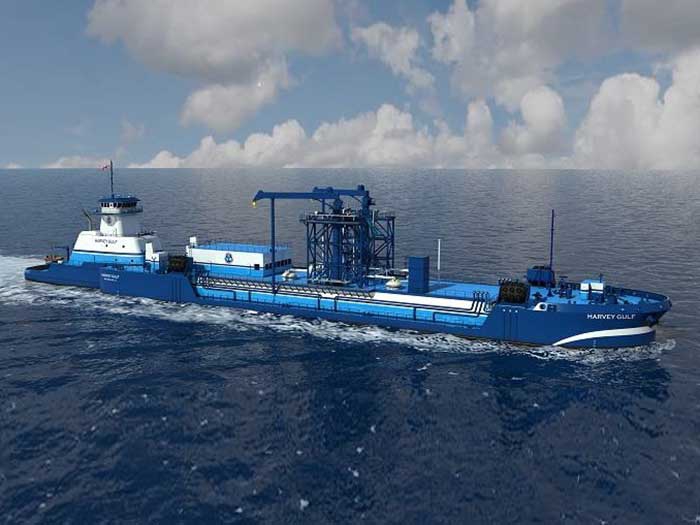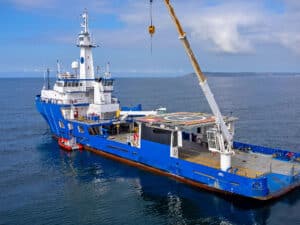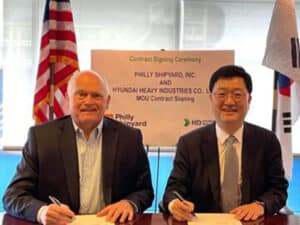
Harvey Gulf gets approvals for LNG transfer ATB
Written by Nick Blenkey
SEPTEMBER 12, 2016 — Harvey Gulf International Marine, LLC, New Orleans, LA, reports that it has received both ABS and U.S. Coast Guard approvals of construction drawings for an LNG-fueled, 4,000 cu. m LNG supply (ATB).
The ATB is designed both for ship-to-ship and shore side resupply transfers of LNG.
“The development of this vessel design highlights our commitment to and involvement in the strengthening of the domestic LNG marine fuel market, and our continued commitment to a leadership role in developing a robust supply infrastructure,” said Harvey Gulf Chairman and CEO Shane J. Guidry.
Harvey Gulf has worked closely with its design partner Waller Marine, and with ABS and the Coast Guard to develop the design package ahead of construction so as to minimize the potential for delays and significant cost impacts to the project during construction in the shipyard.
Harvey Gulf has played a leading role in developing the U.S marine LNG market, including delivering the first U.S. vessel to use LNG as a marine fuel, Harvey Energy, and developing the first U.S. marine LNG refueling terminal at Port Fourchon, LA.
The ATB design meets all domestic and International requirement for a gas carrier, including the existing regulatory requirements defined in 46 CFR Subchapter D, 46 CFR Subchapter 0, the International Code for the Design and Construction of Ships Carrying Liquefied Gases in Bulk, 2016 edition (IGC Code), and applicable ABS Steel Barge Rules: Part 5 Chapter 2 Section 5 Liquefied Gas Tank Barges (as modified per 2016 IGC Code), and ABS Steel Vessel Rules Part 5C Chapter 8 Sections 1-19 (as modified per 2016 IGC Code and referenced within the ABS Barge Rules).
“This project and the methodical approach in which it has been developed is very different from any other similar vessel design project undertaken thus far,” said Chad Verret EVP of LNG Operation at Harvey Gulf. “We are designing a gas carrier that will provided ship-to-ship transfers of LNG to vessels utilizing LNG as a fuel and to do ship-to-shore transfers to small scale marine distribution infrastructure. All while having the ability to load at any Society of International Gas Tanker and Terminal Operators (SIGTTO) compliant off take facility.”
The design features four independent 999 cubic meter type “C” cargo tanks, the ability to load and discharge at a rate of 600 cubic meters per hour and a transit speed in excess of 10 knots.
It incorporates a robust fire and safety system concept for both components of the ATB and the independent ability of the vessels to manage situations as they arise.
Harvey Gulf says that working together with Wärtsilä, the cargo systems integrator, on the complete design, supply, and integration onboard the vessel, assures both functionality and confidence in the operability of the system.
Another key design component of the design is the use of a sub-cooler for boil off gas (BOG) management, using Air Liquide’s Turbo-Brayton Technology (TB 350) as a means to condition the cargo as necessary to manage BOG.
The design’s principal particulars are as follows:
ABS Class + A-1 Towing Vessel, + AMS, ACP, SOLAS, UWILD, OCEAN SERVICE USCG Sub-Chapter M
Tug Length 128′
Tug Beam 42′
Tug Depth 19′
Horsepower 5,100 bhp
ABS Class + A-1 Liquefied Gas Tank Barge, ITB, UWILD, RELIQ, OCEANS SERVICE
Barge LOA 324′
Barge Beam 64′
Barge Depth 32’6″
Barge Max Draft 16′
Cargo Capacity 3,996 cu.m





Leave a Reply
You must be logged in to post a comment.